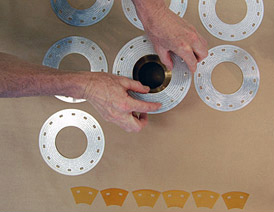
Stacking Bitter plates into a magnet coil.
The resistive magnets that we build here at the National High Magnetic Field Laboratory are the highest-field resistive magnets in the world. They use a technology we call Florida Bitter magnet technology that was invented here in Tallahassee. The approach was first done by Francis Bitter in the 1930s, hence the name "Bitter magnet." The magnets that he made were fairly simple. Here, in the 1990s, we improved the technology dramatically, increased the efficiency of the magnets by 40 percent by optimizing the shape and spacing of the cooling holes. Hence we call the magnets we build here Florida Bitter magnets. They use copper sheet metal with lots of cooling holes in it. We have insulating sheets with the same cooling hole pattern. We stack them into a helix, then put voltage across the coil. High currents flow through the coil, typically about 40,000 amps. Cold water flows through the cooling holes at a speed of about 45 MPH. If you didn't have the cooling water, the magnet would melt in a couple hundredths of a second. Four of the five largest magnet labs in the world now use the Florida Bitter magnet technology.


